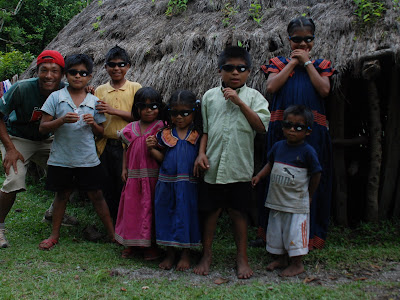
The long-standing Panamanian tradition of the junta brings people together. Everyone counts; everyone carries their weight. The men, women, and children all do what they must to achieve a common goal. Today's goal: make Kalli a house…of mud.
As we stroll from the neighboring town it is noted that we, four other gringos and I, come bearing gifts, most notably 2 chickens and a 5 gallon bucket of guarapo. This is our cooperación or contribution to today’s festivities. Guarapo also known as chicha is a corn drink made with sugar cane sugar. It comes in two varieties: dulce and fuerte. Dulce meaning sweet, is how it first begins, but wait a few days and it ferments and becomes fuerte or strong. This is the fuel for today’s work.
Just as most places in the Panamanian campo, we are warmly welcomed upon arrival. A group of about ten men have already broken ground, that is, they’ve started making the pila. The pila is a perfectly round pit about knee deep and six feet in diameter. Here we will mix dirt, water, and paja or grass to make the walls of the house.
The frame of the house is already in place. It is a simple yet intricate design of posts, sticks, smaller sticks, and vines. The posts or young, debranched tree trunks are attached to stakes, embedded solidly into the ground. The other vertical supports are inch thick sticks evenly spaced between posts. Horizontal support is given by long sticks of the sumba tree. They are attached to all vertical sticks by vines. Victorino explains, “All products are natural.” He continues, “The roof is zinc, that comes from afuera, but it used to be made of dried grass.
As the materials are being collected, we, the gringos, migrate towards a nearby house. In this highly polarized culture, women have assembled in the kitchen to do a different, albeit vital duty for today's junta. They will cook about fifty pounds of rice and 8 chickens worth of soup. Food is crucial to the success of any junta; that and chicha are your day's pay. The women explain, “Today is a small junta, so we will eat chicken. A pig or a cow is necessary for larger ones.”
The pila is today's mixing bowl. The recipe is simple: a lot of water, add mud, and stir. Our feet, moving in a pendulum motion, are the mixers. This step is repeated to desired thickness (think brownie batter only less tasty). The paja is added and submersed to form bloques, a term used jokingly to compare to a house made of cement blocks, a rich person's material.
Today's pila is more than a mixing of ingredients, it's a mixing of cultures. The junta is the campesino's opportunity to describe their culture to the gringos. As we mix, they explain anything from how to make chicha fuerte to the juntas they had back in the day. As the mud mixers get to know each other, we begin to gritar or shout. Somebody shouts, “AOOOOH-AH.” We repeat. If often ends when the gritos get shorter until at once everybody just starts barking like dogs. To the outsider, it may appear that the gritadores are a bit crazy, but once you experience it, you realize that it's simply a way to keep oneself entertained as you work.
Once the pila is well mixed, we hand the amalgamation to the kids and jóvenes who carry it to the house. The kids, earning their day's pay; carry as much as they can. In the process, they cover themselves from head to toe in the mud-grass blend. Others wait at the house and slop it onto the already made frame. Although the house is relatively small, three pilas worth of mud isn't enough to cover all the walls. It will have to be finished another day. As guests in Panamá, we are invited to eat first, our pay. We are each presented with a pile of rice with chicken and yucca in soup broth. The rest, men, women, and children, are then served. Everyone eats. Everyone counts.
As guests in Panamá, we are invited to eat first, our pay. We are each presented with a pile of rice with chicken and yucca in soup broth. The rest, men, women, and children, are then served. Everyone eats. Everyone counts.





